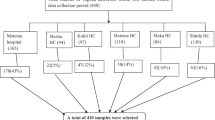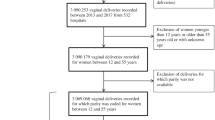Abstract
Purpose
In Singapore, a developed Asian nation, a relatively high proportion of women undergo episiotomy. We assess risk factors and midwife-reported reasons for episiotomy among women undergoing normal vaginal deliveries (NVDs) conducted by midwives and ascertain the association between episiotomy and degree of perineal tear.
Methods
Participants included 77 midwives from a high-volume delivery unit in Singapore. The study had three sequential phases: (1) medical record review of women undergoing NVDs conducted by midwives over a 1-month period to document the proportion with episiotomy; (2) focus group discussions with midwives to form a checklist of reasons for episiotomy; (3) checklist-based documentation of midwife-reported reasons for episiotomy and data collection on maternal, neonatal, practice and midwife factors, and degree of perineal tear among women undergoing NVDs conducted by midwives over a 2-month period. Risk factors for episiotomy were assessed through logistic regression.
Results
Primiparity, advanced maternal age, Indian ethnicity, higher birth weight and older midwife age were associated with episiotomy. The most common midwife-reported reason for episiotomy among primiparous women was primiparity (55.1 %), and among multiparous women was fetal distress (20.0 %) and poor maternal effort (20.0 %). All women with episiotomy sustained at least a second-degree perineal tear versus 27.1 % among women without episiotomy.
Conclusion
Most midwife-reported reasons for episiotomy were not congruent with international practice guidelines. Women without episiotomy have lesser tears than those with episiotomy. Practice protocols and educational programs are needed to change episiotomy practice.

Similar content being viewed by others
References
Lede RL, Belizan JM, Carroli G (1996) Is routine use of episiotomy justified? Am J Obstet Gynecol 174(5):1399–1402. doi:S0002937896002414
Thacker SB, Banta HD (1983) Benefits and risks of episiotomy: an interpretative review of the English language literature, 1860–1980. Obstet Gynecol Surv 38(6):322–338
Woolley RJ (1995) Benefits and risks of episiotomy: a review of the English-language literature since 1980. Part I. Obstet Gynecol Surv 50(11):806–820
Carroli G, Mignini L (2009) Episiotomy for vaginal birth. Cochrane Database Syst Rev (1):CD000081. doi:10.1002/14651858.CD000081.pub2
Viswanathan M, Hartmann K, Palmieri R, Lux L, Swinson T, Lohr KN, Gartlehner G, Thorp J Jr (2005) The use of episiotomy in obstetrical care: a systematic review. Evid Rep Technol Assess (Summ) 112:1–8
Signorello LB, Harlow BL, Chekos AK, Repke JT (2001) Postpartum sexual functioning and its relationship to perineal trauma: a retrospective cohort study of primiparous women. Am J Obstet Gynecol 184(5):881–888. doi:10.1067/mob.2001.113855 (discussion 888–890)
American College of Obstetricians and Gynecologists (2006) Episiotomy. ACOG practice bulletin no. 71. Obstet Gynecol 107:957–962
National Institute for Health and Clinical Excellence (2007) CG55 intrapartum care: care of healthy women and their babies during childbirth. RCOG Press, London
Graham ID, Carroli G, Davies C, Medves JM (2005) Episiotomy rates around the world: an update. Birth 32(3):219–223. doi:10.1111/j.0730-7659.2005.00373.x
Dahlen H, Homer C (2008) Perineal trauma and postpartum perineal morbidity in Asian and non-Asian primiparous women giving birth in Australia. J Obstet Gynecol Neonatal Nurs 37(4):455–463. doi:10.1111/j.1552-6909.2008.00259.x
Green JR, Soohoo SL (1989) Factors associated with rectal injury in spontaneous deliveries. Obstet Gynecol 73(5 Pt 1):732–738
Goldberg J, Hyslop T, Tolosa JE, Sultana C (2003) Racial differences in severe perineal lacerations after vaginal delivery. Am J Obstet Gynecol 188(4):1063–1067. doi:S0002937803000735
McCandlish R, Bowler U, van Asten H, Berridge G, Winter C, Sames L, Garcia J, Renfrew M, Elbourne D (1998) A randomised controlled trial of care of the perineum during second stage of normal labour. Br J Obstet Gynaecol 105(12):1262–1272
Kok J, Tan KH, Koh S, Cheng PS, Lim WY, Yew ML, Yeo GS (2004) Antenatal use of a novel vaginal birth training device by term primiparous women in Singapore. Singapore Med J 45(7):318–323
Goldberg J, Purfield P, Roberts N, Lupinacci P, Fagan M, Hyslop T (2006) The Philadelphia episiotomy intervention study. J Reprod Med 51(8):603–609
Wu LC, Lie D, Malhotra R, Allen JC, Tay JSL, Tan TC, Østbye T (2013) What factors influence midwives’ decision to perform or avoid episiotomies? A focus group study. Midwifery. doi:10.1016/j.midw.2012.11.017
Royal College of Midwives (2008) Care of the perineum. Midwifery practice guideline. RCM, London
Fernando R, Sultan AH, Kettle C, Thakar R, Radley S (2006) Methods of repair for obstetric anal sphincter injury. Cochrane Database Syst Rev (3):CD002866. doi:10.1002/14651858.CD002866.pub2
Carvalho CC, Souza AS, Moraes Filho OB (2010) Prevalence and factors associated with practice of episiotomy at a maternity school in Recife, Pernambuco, Brazil. Rev Assoc Med Bras 56(3):333–339. doi:S0104-42302010000300020
Ogunyemi D, Manigat B, Marquis J, Bazargan M (2006) Demographic variations and clinical associations of episiotomy and severe perineal lacerations in vaginal delivery. J Natl Med Assoc 98(11):1874–1881
Hornemann A, Kamischke A, Luedders DW, Beyer DA, Diedrich K, Bohlmann MK (2010) Advanced age is a risk factor for higher grade perineal lacerations during delivery in nulliparous women. Arch Gynecol Obstet 281(1):59–64. doi:10.1007/s00404-009-1063-7
Howard D, Davies PS, DeLancey JO, Small Y (2000) Differences in perineal lacerations in black and white primiparas. Obstet Gynecol 96(4):622–624. doi:S0029-7844(00)00956-X
Lu PL (2010) Selective versus routine episiotomy for Chinese primiparous women: Hong Kong midwives’ concerns. Hong Kong Polytechnic University Electronic Theses:134, Hong Kong
Dahlen HG, Homer CS, Leap N, Tracy SK (2011) From social to surgical: historical perspectives on perineal care during labour and birth. Women Birth 24(3):105–111. doi:10.1016/j.wombi.2010.09.002
Henriksen TB, Bek KM, Hedegaard M, Secher NJ (1992) Episiotomy and perineal lesions in spontaneous vaginal deliveries. Br J Obstet Gynaecol 99(12):950–954
The Accoucheur: A Newsletter for Primary Care in Childbirth (1994) Reducing Episiotomy (editorial). April (1):3
Acknowledgments
We would like to express our gratitude to the sisters, staff nurses and midwives at KKH delivery suite and to colleagues Chee Wai and Chen-Hsin for their helpful comments on this paper. We appreciate the support of SingHealth/Duke-NUS Academic Medicine Research Institute Singapore and the assistance of Taara Madhavan (Associate in Clinical Sciences, Duke-NUS Graduate Medical School, Singapore) and Chandima Arambepola (Research Assistant, Duke-NUS Graduate Medical School, Singapore) in editing this manuscript.
Conflict of interest
We declare that we have no conflict of interest.
Author information
Authors and Affiliations
Corresponding author
Rights and permissions
About this article
Cite this article
Wu, L.C., Malhotra, R., Allen, J.C. et al. Risk factors and midwife-reported reasons for episiotomy in women undergoing normal vaginal delivery. Arch Gynecol Obstet 288, 1249–1256 (2013). https://doi.org/10.1007/s00404-013-2897-6
Received:
Accepted:
Published:
Issue Date:
DOI: https://doi.org/10.1007/s00404-013-2897-6




